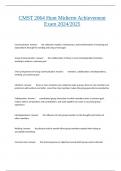CMST 2064 Hunt Midterm Achievement
Exam 2024/2025
Communication Answer: the collective creation, maintenance, and transformation of meaning and
expectations through the sending and using of messages
Group Communication Answer: the collaboration of three or more interdependent members
working to achieve a common goal
5 Key Components of Group Communication Answer: members, collaboration, interdependence,
working, and common goal
Members Answer: three or more members are needed to make a group, three to nine members are
preferred, odd numbers are better, more than nine members makes the group generally less productive
Collaboration Answer: coordinated group interaction in which members share a common goal,
respect others' perspectives and contributions, and work together to create a successful group
experience
Interdependence Answer: the influence of each group member on the thoughts and actions of
other members
Working Answer: the physical and/or mental effort group members expend when trying to
accomplish something
Common Goal Answer: the shared purpose or objective toward which group work is directed
,Systems Theory Answer: encompasses a group of theories that examines how interdependent
factors affect one another in a complex environment, recognizes that "communication does not take
place in isolation, but rather necessitates a communication"
8 Types of Groups Answer: primary, social, self-help, learning, service, civic, organizational, and
public
Primary Group Answer: its purpose is to provide members with affection, support, and a sense of
self-belonging; examples are family and best friends
Social Group Answer: its purpose is to share common interests in a friendly setting or participate in
social activities; examples are athletic teams and college sororities and fraternities
Self-Help Group Answer: its purpose is to support and encourage members who want or need help
with personal problems; examples are therapy groups and weight watchers
Learning Group Answer: its purpose is to help members gain knowledge and develop skills;
examples are study groups and ceramic workshops
Service Group Answer: its purpose is to assist worthy causes that help other people outside the
group; examples are kiwanis and charity or volunteer groups
Civic Group Answer: its purpose is to support worthy causes that help people within the group;
examples are PTA and neighborhood associations
Organizational Group Answer: its purpose is to achieve specific goals on behalf of a business or
organization; examples are management teams and committees
, Public Group Answer: its purpose is to discuss important issues in the front of or for the benefit of
the public; examples are open-to-the-public panel discussions and governance groups
Virtual Teams Answer: rely on one or more mediated technologies to collaborate, often across time,
distance, and organizational boundaries
Top-Rated Characteristics of an Effective Virtual Teammate Answer: a willingness to share relevant
information, active engagement and interaction with others, and the ability to collaborate
Strategic Approach to Communication Answer: goal setting, situational knowledge, communication
competence, and anxiety management
Praxis Answer: learning in the doing
Advantages of Working in Groups Answer: superior resources, member satisfaction, learning,
cultural understanding, creativity, and civic engagement
Disadvantages of Working in Groups Answer: consume time, energy, and resources, conflict, people
problems, communication, and reduction
Group Dialectics Answer: individual vs. group goals, conflict vs. cohesion, conforming vs.
nonconforming, task vs. social dimension, homogenous vs. heterogeneous, leadership vs. followership,
structure vs. spontaneity, engaged vs. disengaged, and open vs. closed systems
5 Group Development Stages Answer: forming, storming, norming, performing, and adjourning
Forming Stage Answer: members become acquainted with one another and attempt to understand
the nature of their task; primary tension is in this stage




